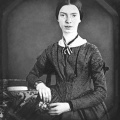 One of the most mysterious and extraordinarily talented women in the history of American poetry Emily Elizabeth Dickinson was born on December 10, 1830 in New England to a Puritan family that had lived in Massachusetts since the 17th century. His father, Edward Dickinson, was a lawyer and politician, a long-time member of the state house of representatives and Senate, and a U.S. Congressman. Mother-Emily Dickinson, nee Norcross. Emily was the middle of three children: her brother William Austin (known as Osti) was a year older than her, and her sister Lavinia was three years younger. The house in Amherst where Emily Dickinson was born is now home to her Memorial Museum.
One of the most mysterious and extraordinarily talented women in the history of American poetry Emily Elizabeth Dickinson was born on December 10, 1830 in New England to a Puritan family that had lived in Massachusetts since the 17th century. His father, Edward Dickinson, was a lawyer and politician, a long-time member of the state house of representatives and Senate, and a U.S. Congressman. Mother-Emily Dickinson, nee Norcross. Emily was the middle of three children: her brother William Austin (known as Osti) was a year older than her, and her sister Lavinia was three years younger. The house in Amherst where Emily Dickinson was born is now home to her Memorial Museum.
He attended elementary school at Pleasant Street in Amherst. In 1840, she began simultaneously with her sister studying at the Amherst Academy, which only two years earlier had begun to accept girls. She spent seven years at the Academy, missing several semesters due to illness. She studied English, Latin, literature, history, botany, geology, psychology, and arithmetic. Many acquaintances started at the Academy continued throughout the life of Emily Dickinson. She graduated from the Academy in the summer of 1847. From August 10 to March 25, 1848, she studied at the Mount Holyoke Female Seminary, 16 km from Amherst. The reasons for her departure from the Seminary are unknown. After Seminary, she returned to her parents ' family in Amherst and lived there for the rest of her life, rarely moving more than five miles from home.
Despite the strict puritanical mores in the family, Dickinson was familiar with modern literature. In particular, her family friend Benjamin Franklin Newton introduced her to the poetry of, among others, Wordsworth and Emerson.
In the spring of 1855, she made one of her longest trips with her mother and sister, spending three weeks in Washington, where her father represented Massachusetts in Congress, and then two weeks in Philadelphia. In particular, in Philadelphia, she met the clergyman Charles Wadsworth, who became one of her closest friends, and, despite the fact that they subsequently saw each other only twice, until his death in 1882, had a serious influence on her. Neighbors considered her eccentric, in particular, because she always wore a white dress and rarely went out to greet guests, and later did not leave her room at all. Most of her friends did not know her personally, but only corresponded with her.
After parting in 1862 with the man she loved, she practically stopped communicating with people, except for relatives and closest friends. Dickinson wrote that the idea of publishing "is as alien to her as the firmament is to the fin of a fish." The first book of "Poems by Emily Dickinson", was published posthumously in 1890 and was a success. This publication was followed by many others. Now considered one of the most important figures of American and world poetry, and also the most widely read American poet of all time in the world and in his country.
During her lifetime, she published less than 10 poems out of 1800 written by her. Dickinson's poems have no analogues in contemporary poetry. Their lines are short, names are usually omitted, and unusual punctuation and use of capital letters are common. Many of her poems contain the motif of death and immortality; the same themes permeate her letters to friends. The scale of her work became known only after her death, when her younger sister Lavinia discovered unpublished works in 1886. The first collection of Dickinson's poetry was published in 1890 and was heavily edited; a complete and almost unedited edition was issued in 1955 by Thomas Johnson. Although the publications received unfavorable reviews from critics in the late 19th and early 20th centuries, Emily Dickinson is now regarded by critics as one of the greatest American poets. In the English-speaking world, her work is actively researched; there is a lot of literature on the subject.
Nazira Artykbaeva, Librarian of the International Book Department

